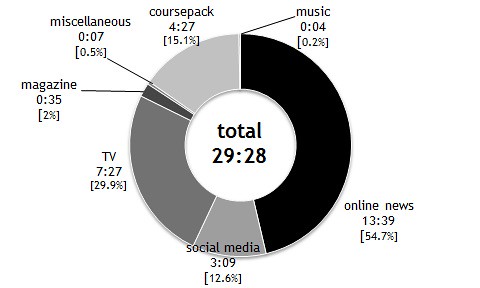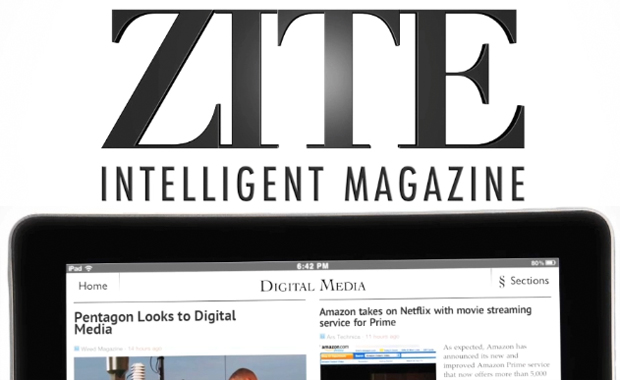Last Wednesday, immediately prior to attending an event on media diets, we presented a week’s compilation of our own media diets. The day’s scheduled events were rather meta with regards to conscious information consumption, and this turned out to be, in many ways, a theme of my diet.
Not counting this assignment, other meta media experiences included:
- Watching The Matrix with a comedic audio track overlay
- A Twitter feed following over 1,600 people and organizations, many of them political operatives operating in and around the day’s headlines
- Watching Saturday Night Live lampoon the week’s news
- A substantial period of time attending classes on particpatory news and social television habits

As you can see in the chart above, I aggregated the elements of my media diet into five categories (left to right):
Traditional news consisted of news websites and print magazine subscriptions:
Relaxation and entertainment included reading blogs, listening to music during workouts, and watching streaming TV shows on Hulu:

Creative production included writing, notetaking, creating graphics, and giving a presentation:
Focused learning included conducting research, learning to code, watching tutorials, and listening to lectures:
Social intelligence included Twitter, Gmail, Facebook, instant messaging, and extended face-to-face conversations:

Lean-Forward Information Consumer
I’ve long been an early adopter and devoted Lifehacker reader. I install and try out most of the programs, plugins, apps, and web services that cross my path. I’ve chosen lean-forward interaction over lean-back entertainment since I’ve had access to a modem. As a result, I’ve spent a lot of time thinking about how to strike a balance between the potential of digital media and the warmth and history of analog media. And yet there were still a number of surprises gained from obsessively tracking my habits for a week.
Protect Time to Create
Arguably the most disruptive feature of participatory media is that it asks us to write information as well as read it. If consuming media is like consuming food, the metaphor extends to suggest that we consider the creation of media to be a form of exercise. Writing, coding, filming, and otherwise producing original content requires us to flex our creative muscles in a different way, similar to the shift between passively learning a field and actively teaching it to another person.
I was pleased to see how much time I spent actively creating content over the course of the week. My first semester at the Media Lab made it quite clear that it was possible to spend most of one’s time attending really interesting panels and classes, and reading an endless supply of academic literature, organizational reports, and course readings, all at the expense of producing any original work oneself. The limits imposed by time regularly force a decision between the immediate benefits of listening to someone much smarter than myself, and the longer-term journey to build my own skills and enunciate my own thoughts. I credit my group’s encouragement (and occasional mandate) to blog frequently.
Status Update as Atomic Unit of News?
Melissa Mayer of Google defended Google News’s aggregation of content by pointing out that the article has become the atomic unit of the news. Looking over my RescueTime reports, it became clear that sitting down with even an article or full blog post has become a somewhat rare experience during the week. Most of my dedicated news-reading time came during the weekend, like other leisure activities. The many interesting links Twitter tempts me with throughout my work day are bookmarked with a ReadItLater extension, and then automagically whisked away to wait for me on my Kindle, thanks to a recipe over at ifttt.
This is not to say that I am not aware of the news during the week. I spend most of my days actively plugged into what’s happening, but this information comes to me via Twitter, Facebook, and status messages on Gchat. It’s been written elsewhere, but the combination of real news and social intelligence is a killer combination, one that routinely crowns Twitter my most-consulted news medium. And, if awareness of the top Google Trends is an indication, these sources effectively keep me informed.
Absolute Time vs. Interrupted Time
For the value it provides as a social utility, Facebook really doesn’t take up much of my time each day (only  8-10 minutes a day, spread out over more visits than I’d like to admit). That said, it was clear in my diary that tracking with tools like RescueTime won’t measure the true distraction of applications like Twitter and Facebook, or the time spent on my phone. The total amount of time spent on these social networks is relatively low, but quick consultations ensure they influence large blocks of time throughout the day.
8-10 minutes a day, spread out over more visits than I’d like to admit). That said, it was clear in my diary that tracking with tools like RescueTime won’t measure the true distraction of applications like Twitter and Facebook, or the time spent on my phone. The total amount of time spent on these social networks is relatively low, but quick consultations ensure they influence large blocks of time throughout the day.
One way Twitter influences my day more than the accumulated minutes suggest is in its role as provider of clickworthy links. Both RescueTime and my browser history show a large sample of quick hit webpages where I spend under a minute. This is common behavior for users across the web, but I was a bit surprised at just how many pages (over 2,400) I navigated through in a week.
Conversation as Information Medium
 Ethan hinted that, if we took our media diet tracking far enough, we might begin to consider conversations as a form of media. I decided to go with it, because despite the success of social media platforms, we still receive much of our intelligence in regular conversations with other human beings. I already knew, thanks to Fitbit, that weekends are much healthier for me, as I walk and sleep more. Tracking my media diet showed me that weekends are also healthier for my social soul, as I spent much more time in face-to-face conversations.
Ethan hinted that, if we took our media diet tracking far enough, we might begin to consider conversations as a form of media. I decided to go with it, because despite the success of social media platforms, we still receive much of our intelligence in regular conversations with other human beings. I already knew, thanks to Fitbit, that weekends are much healthier for me, as I walk and sleep more. Tracking my media diet showed me that weekends are also healthier for my social soul, as I spent much more time in face-to-face conversations.
Lastly, my email inbox was an interesting source of information. A small army of Gmail filters protects my actual inbox, but I still pick up a fair amount of news about political and social campaigns from a wide range of newsletters and listservs. As a result, I currently receive over 14 times more email than I send.
Bar chart color scheme by The Cooler shared under Creative Commons BY-NC-SA license. Icons by The Noun Project shared under Creative Commons BY 3.0 license.



